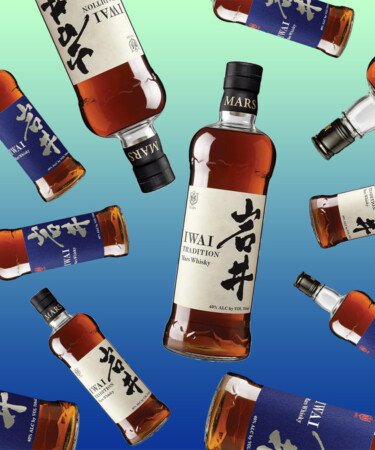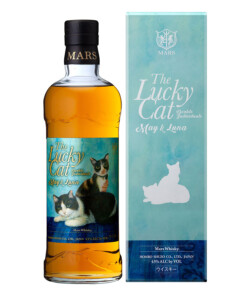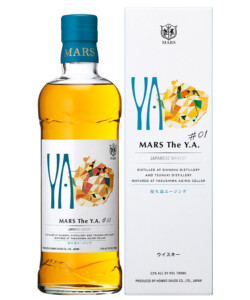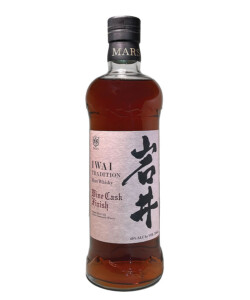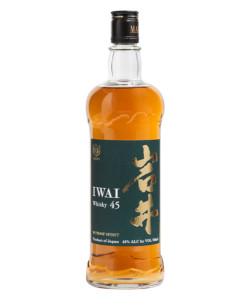Sometimes, a new sense of scenery can be transformative — as was the case with one of Japan’s oldest and most boundary-pushing whisky brands.
Mars Whisky was born in 1949 as a collaboration between legendary distiller Kiichiro Iwai and the Hombo family, which has been distilling shochu since 1873. But when the Mars distillery finally opened in Kagoshima in 1960, the whisky received little fanfare from the public, as it was found to be too smoky and heavy for Japanese drinkers. The distillery was relocated to Nagano, a city high in the Japanese alps abundant with glacial water, which resulted in softer, less peated whisky. The move would prove to be one of the wisest choices the brand would ever make.
Today, Mars Whisky distills its whisky at two distilleries and ages it across three warehouses — each of which experiences dramatically different climates, resulting in unique spirits that represent Japan’s complex terroir. The brand continues to be owned and operated by Hombo Shuzo Co., which currently employs four generations of the Hombo family. Now that you know the basics, here are 10 more things you should know about Mars Whisky.
-
Kiichiro Iwai was a silent Japanese whisky trailblazer.
Prior to partnering with the Hombo family, Iwai distilled for years at Settsu Shuzo in Osaka. At the distillery, Iwai served as the direct superior to an employee who would eventually become a revolutionary whisky distiller, Masataka Taketsuru. At Settsu Shuzo, Iwai found that Taketsuru displayed a special aptitude for distilling, so he selected Taketsuru to study chemistry and western whisky distillation at the University of Glasgow in Scotland, where he remained for over five years. During his studies, Taketsuru also interned at a number of distilleries, including the now-defunct Hazelburn, where he recorded notes on grain maltings, milling, fermentation to barrels, still maintenance, and craft distilling. These notes are now collectively referred to in the Japanese whisky world as the Taketsuru report. When Taketsuru returned to Japan, he and Iwai were unfortunately unable to partner on a distillery, and Taketsusu instead opened Nikka Whisky, the third operational whisky distillery in Japan. Twenty-five years later, Iwai would open Mars, the nation’s fourth whisky distillery.
-
After World War II, Iwai partnered with the Hombo family to found a distillery with a distinctly Scottish influence.
It wasn’t until after World War II that Iwai had enough funds to open his own distillery, at which point he partnered with respected shochu distillers, the Hombo family. The name Mars was chosen in homage to the Roman god of war and guardian of agriculture. Using the Taketsuru report, Iwai laid the foundation for future distilling operations and designing pot stills. As most of these plans stemmed from info gleaned by Taketsuru and his time in Scotland, where spirits are produced with high concentrations of peat and smoke flavors, Mars’ whisky took on the same profile. Those flavors would prove too powerful for Japanese palates in 1960.
-
In 1985, the distillery relocated and became Japan’s highest-elevation whisky distillery.
On a quest to produce a more delicate spirit for consumers, Mars was relocated to the Miyada village in the Nagano Prefecture. There, the new distillery was opened under the name Mars Shinshu, which has recently been renamed Mars Komagatake. Located between Japan’s southern and central alps at the foot of Mt. Kiso-Komagatake, Mars Komagatake sits just over 2,600 feet above sea level, making it the highest-altitude distillery in the country. The alpine location has an abundance of fresh, glacial water running underground that’s filtered naturally through granite rock, making for soft water with low minerality ideal for distilling. Despite the location being an excellent source of fresh water, it was the soaring heights and low temperatures that drew the Hombo family in. The high altitude, combined with an annual average temperature of approximately 54 degrees Fahrenheit, resulted in a slower maturation period in the distillery’s cellar and thus a higher concentration of aromas and complexity in its whisky.
-
Komagatake was out of commission for almost 20 years.
After the distillery was relocated to the Japanese alps, the brand took off, with Japanese drinkers flocking to the lighter style of whisky the location allowed for. The distillery was prosperous from 1985 to 1992. That year, the Japanese economy crashed, and the Hombo family was forced to shutter their distilling operation. While Mars was able to sell off older bottles of aged whisky expressions for a short time following the initial closure, once stocks ran out, the distillery was mothballed entirely. In 2011, it was finally able to reopen its doors following a resurgence of interest in Japanese whisky across the country. Nineteen years later, the brand renewed its approach to distilling single malts, aligning with contemporary revolutionaries like Ichiro Akuto of Chichibu Distillery, the only distillery in the world to use 100 percent mizunara Japanese oak washbacks for fermentation.
-
The whisky is also distilled in Japan’s southernmost whisky distillery.
Five years after Komagatake reopened, the brand expanded its operations with a second distillery: Mars Tsunuki, stationed over 750 miles south of the alpine distillery. Kagoshima is widely considered to be the birthplace of shochu, and the sequel distillery pays homage to the Hombo family’s roots in distilling the Japanese spirit. Whereas Mars Komagatake is the highest distillery in all of Japan, Mars Tsunuki is the southernmost, located on the island of Kyūshū. The distillery sits at sea level and experiences a year-round subtropical, humid climate that speeds up maturation and results in higher angel’s share, making for oilier whiskies with a greater emphasis on smoky flavors. The whisky produced at Mars Tsunuki also tends to be a bit lower in ABV than those produced at Mars Komagatake, as elevated humidity leads to a slower loss of water than ethyl alcohol and a less concentrated spirit. The brand experiments regularly with distillates produced at each location, sending them to the other to mature and taking note of the unique terroir each location brings to the aging spirits.
-
…and a new maturation warehouse on Yakushima Island to age whisky.
The same year the Mars Tsunuki distillery opened, the brand constructed a new aging facility on the small island of Yakushima, a UNESCO World Heritage site. The island, located approximately 40 miles off the coast of Kagoshima, is exposed to an abundance of ocean air and experiences near-constant rainfall, providing an extremely humid environment for aging. In addition to maturation warehouses at each of the distilleries, the brand uses the warehouse on Yakushima (aptly named the Yakushima Cellar) to age whiskies produced at both locations in ex-bourbon or ex-sherry casks. The brand’s Y.A. Series, which currently has two expressions, was created to observe the influence the Yakushima Cellar has on aging whisky distilled at both distilleries.
-
The brand uses several types of casks to age its spirits.
With two distilleries and three total maturation warehouses, Mars Whisky doesn’t shy away from experimenting, and the casks it uses are no exception. While the spirits aged on Yakushima are restricted to ex-bourbon and ex-sherry, Mars Whisky utilizes Madeira, port, and French oak wine casks at onsite warehouses, along with IPA casks and white oak casks used to age Japanese umeshu, a plum wine, shochu, and sakura. All casks at Mars are used between four and six times before new ones are sourced, and have been used to produce over 60 unique whisky expressions.
-
Mars partnered with the Chichibu Distillery to commemorate the 2020 Tokyo Olympics.
Ahead of Japan hosting its first Summer Games since 1964, Mars partnered with the Chichibu Distillery in 2015 to produce a whisky to commemorate the event. Five years before the games were set to kick off, both brands traded new-make whiskey from their distilleries and left them to age in the other’s maturation warehouse. Over the years, both brands watched the other’s whisky closely, reporting back on how it was evolving. At the end of the process, the two distillates were married together for a unique whisky that is equal parts Mars and Chichibu. According to the brand, the 108-proof whisky delivers notes of green plum, citrus, brown sugar, and a hint of tobacco.
-
At the Tsunuki distillery, the brand also distills a gin.
Despite the fact that Mars Whisky is obviously associated with, well, whisky, the brand also launched a gin in 2017. Distilled at Mars Tsunuki, Wa Bi — which translates to “Japanese beauty” — is distilled from rice and infused with juniper and nine botanicals native to Kagoshima Prefecture: kumquat, Hassaku oranges, lemons, yuzu, ginger, green tea, shell ginger, cinnamon leaf, and shiso. The gin is exclusively produced in small batches.
-
Mars also operates a winery near Mount Fuji.
The brand also operates the Mars Hosaka Winery in Yamanashi Prefecture, Japan’s top-producing wine region. Established in 2017, the winery produces wine using grapes harvested on the Hosaka Hinojo Farm, which was opened by Mars Wine in Yamanashi in 2000. There, grapes grow on vines planted with a gravity flow design, which decreases the stress on vines and increases sunlight exposure. By using these cultivation techniques, the grapes are able to develop a higher level of flavor concentration and more body in the wines. The winery and its sibling distilleries are very closely connected, and the brand’s whiskies are often aged in casks first used to age the winery’s flagship Château Mars vintages.
